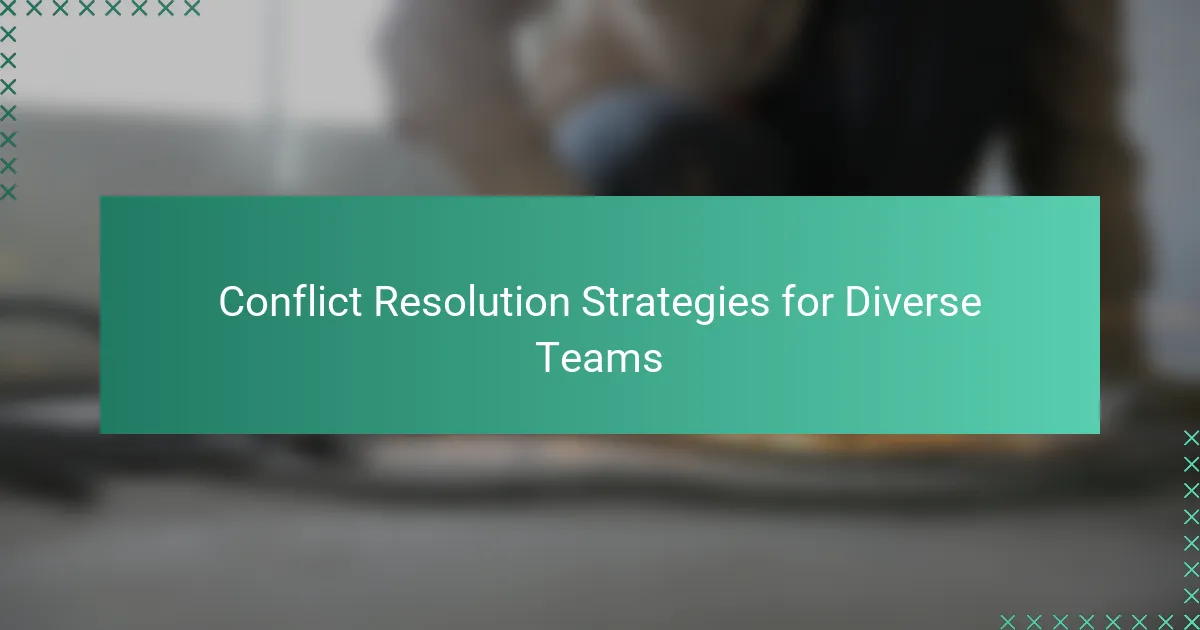Conflict resolution strategies for diverse teams are essential for fostering effective collaboration and productivity. Key strategies include open communication, active listening, and collaborative problem-solving, which create an environment where team members can express their views and work together to find solutions. Establishing ground rules for discussions and providing cultural competence training further enhance understanding among team members. Mediation by a neutral third party can also facilitate resolution in complex conflicts. Implementing these strategies helps organizations maintain a positive workplace culture and reduce employee turnover.
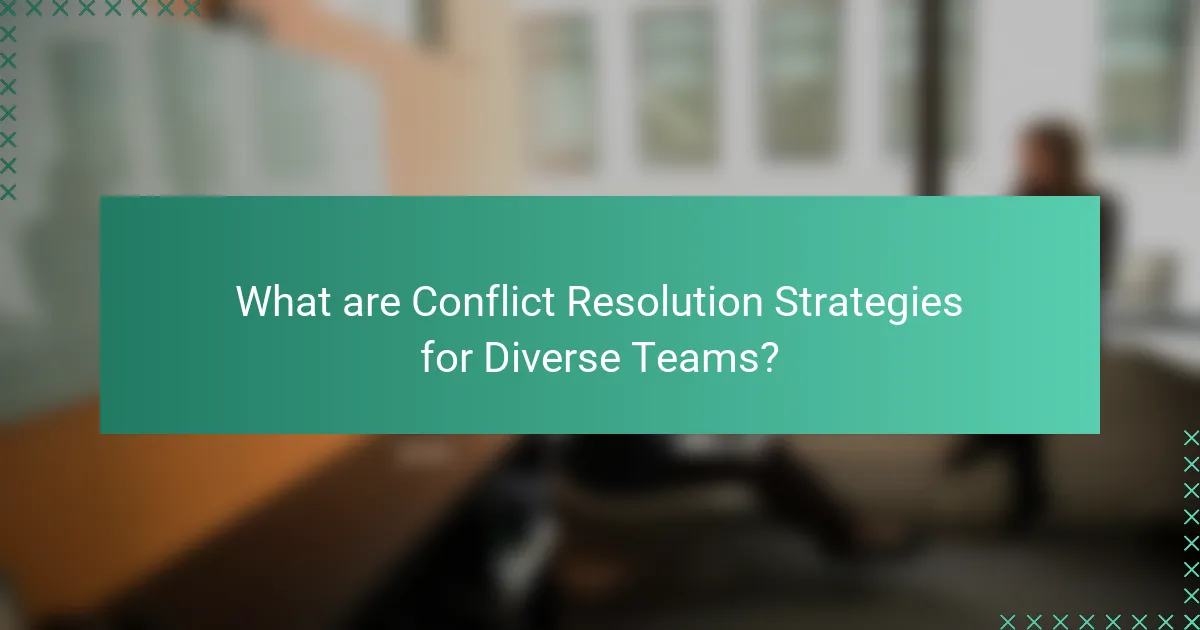
What are Conflict Resolution Strategies for Diverse Teams?
Conflict resolution strategies for diverse teams include open communication, active listening, and collaborative problem-solving. Open communication fosters an environment where team members can express their views. This approach helps to clarify misunderstandings and reduces tension. Active listening ensures that all voices are heard, validating each member’s perspective. Collaborative problem-solving encourages team members to work together to find solutions that accommodate diverse viewpoints.
Additionally, establishing ground rules for discussions can create a respectful atmosphere. Providing cultural competence training enhances understanding of different backgrounds. Mediation by a neutral third party can also facilitate resolution in more complex conflicts. These strategies are effective because they promote inclusivity and respect, leading to better team dynamics and productivity.
Why is conflict resolution important in diverse teams?
Conflict resolution is important in diverse teams because it fosters collaboration and understanding among team members. Diverse teams often bring different perspectives and cultural backgrounds. These differences can lead to misunderstandings and conflicts. Effective conflict resolution helps to address these issues constructively. It promotes open communication and encourages respect for differing viewpoints. Research shows that teams with effective conflict resolution strategies are more innovative and productive. According to a study published in the Journal of Organizational Behavior, teams that engage in constructive conflict resolution experience higher levels of collaboration and satisfaction. Thus, conflict resolution is essential for maximizing the strengths of diverse teams.
What types of conflicts commonly arise in diverse teams?
Common conflicts in diverse teams include communication issues, cultural misunderstandings, and differing work styles. Communication issues arise from language barriers or varying communication preferences. Cultural misunderstandings can lead to misinterpretation of behaviors or values. Differing work styles may create friction between team members who prioritize tasks differently. Research indicates that these conflicts can hinder team performance and collaboration. A study by Jehn (1995) highlights that task-related conflicts are common in diverse groups, impacting overall effectiveness.
How does diversity impact conflict dynamics?
Diversity impacts conflict dynamics by introducing varying perspectives and communication styles. This variation can lead to misunderstandings and misinterpretations. For instance, cultural differences may cause individuals to interpret conflict cues differently. A study by Jehn and Mannix (2001) found that diverse teams experience both task-related conflicts and relationship conflicts. Task-related conflicts can enhance problem-solving by bringing in multiple viewpoints. However, relationship conflicts can escalate tensions if not managed properly. Effective conflict resolution strategies must consider these diverse perspectives to foster collaboration. Understanding diversity’s role in conflict can improve team dynamics and outcomes.
What are the key principles of effective conflict resolution?
The key principles of effective conflict resolution include open communication, active listening, and collaboration. Open communication ensures all parties express their views clearly. This transparency builds trust and understanding among team members. Active listening involves paying attention to others’ perspectives without interruption. It fosters empathy and helps identify underlying issues. Collaboration encourages finding mutually beneficial solutions. This principle promotes teamwork and collective problem-solving. Additionally, maintaining respect throughout the process is crucial. Respectful interactions reduce defensiveness and facilitate constructive dialogue. Lastly, focusing on interests rather than positions leads to more effective outcomes. This approach allows for creative solutions that satisfy everyone’s needs.
How do communication styles affect conflict resolution?
Communication styles significantly influence conflict resolution. Different styles can either facilitate or hinder the resolution process. For instance, assertive communication encourages open dialogue and clarity. This approach helps parties express their needs without aggression. Conversely, passive communication may lead to misunderstandings. Individuals using this style often avoid confrontation, which can prolong conflicts.
Research indicates that collaborative communication leads to better outcomes in conflict situations. A study by Thomas-Kilmann identifies five conflict-handling modes, emphasizing the importance of adapting communication styles to the context. Effective communication fosters empathy and understanding, essential for resolving conflicts. Therefore, recognizing and adapting to various communication styles is crucial for successful conflict resolution in diverse teams.
What role does empathy play in resolving conflicts?
Empathy plays a crucial role in resolving conflicts by fostering understanding between opposing parties. It allows individuals to recognize and appreciate each other’s feelings and perspectives. This understanding can reduce hostility and promote cooperation. Empathy encourages open communication, which is essential for conflict resolution. According to a study published in the Journal of Conflict Resolution, empathetic approaches lead to more successful negotiation outcomes. By acknowledging emotions, parties can find common ground more effectively. This process can transform adversarial interactions into collaborative problem-solving. Thus, empathy is a key component in facilitating resolution in diverse teams.
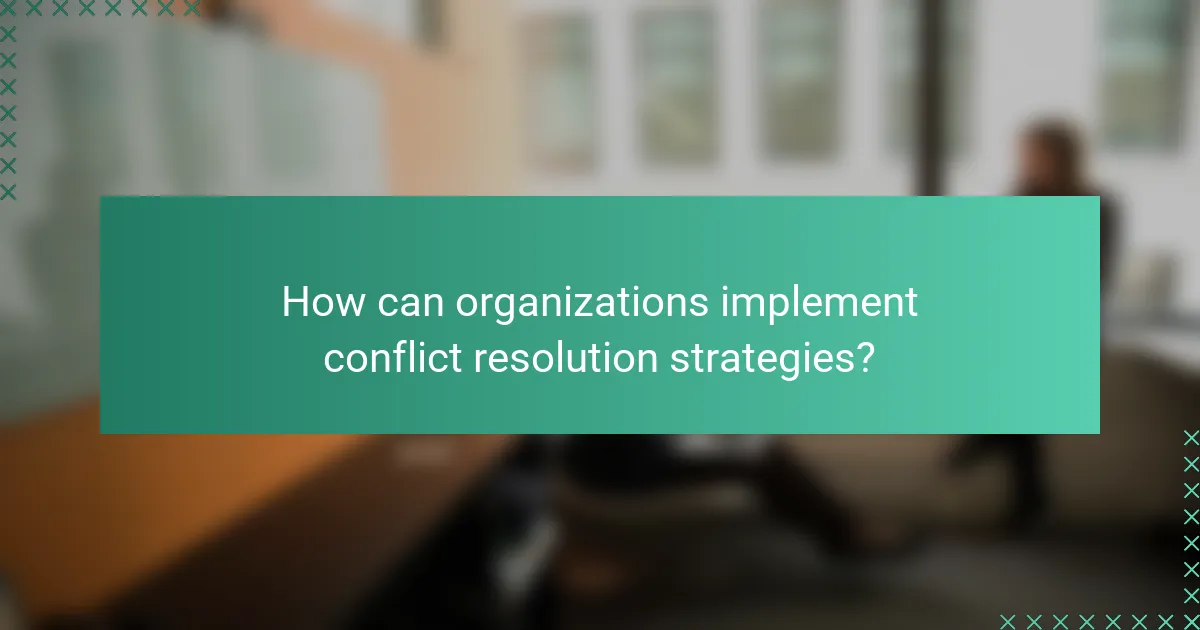
How can organizations implement conflict resolution strategies?
Organizations can implement conflict resolution strategies by establishing clear communication channels. Effective communication allows team members to express their concerns openly. Training staff in conflict resolution techniques is also essential. This training equips employees with the skills to manage disputes constructively.
Additionally, organizations should encourage a collaborative environment. A culture of teamwork fosters understanding and reduces tensions. Implementing mediation processes can help resolve conflicts before they escalate. Mediation provides a neutral space for parties to discuss their issues.
Regularly reviewing conflict resolution policies is crucial. This ensures that strategies remain relevant and effective. Research shows that organizations with structured conflict resolution processes experience less employee turnover. This indicates that effective strategies contribute to a positive workplace culture.
What steps should organizations take to foster a resolution-friendly environment?
Organizations should implement clear communication policies to foster a resolution-friendly environment. Open channels for dialogue encourage team members to express concerns. Regular training in conflict resolution skills promotes understanding and empathy. Establishing a safe space for discussions helps reduce fear of repercussions. Encouraging collaboration on problem-solving builds trust among team members. Leadership should model conflict resolution behaviors to set a positive example. Providing resources, such as mediation services, can facilitate effective resolutions. Finally, regularly assessing the workplace culture ensures ongoing improvement in conflict management practices.
How can training programs enhance conflict resolution skills?
Training programs can enhance conflict resolution skills by providing structured learning experiences. These programs teach participants effective communication techniques. They also offer strategies for identifying underlying issues in conflicts. Role-playing scenarios allow individuals to practice responses in a safe environment. Feedback from trainers helps refine conflict resolution approaches. Research indicates that trained individuals are more likely to resolve disputes amicably. According to a study by Jehn and Mannix (2001), teams with conflict resolution training experience improved collaboration and reduced misunderstandings. Overall, training equips individuals with the tools needed to navigate conflicts successfully.
What policies support effective conflict resolution in diverse teams?
Policies that support effective conflict resolution in diverse teams include clear communication guidelines, diversity training, and conflict resolution frameworks. Clear communication guidelines help ensure that all team members express their thoughts and feelings openly. Diversity training fosters understanding and respect among team members from different backgrounds. Conflict resolution frameworks provide structured approaches for addressing disputes, ensuring fairness and consistency. Research indicates that teams with established conflict resolution policies experience reduced misunderstandings and increased collaboration. These policies create an environment where diverse perspectives are valued, leading to improved team dynamics and performance.
How can leaders facilitate conflict resolution in diverse teams?
Leaders can facilitate conflict resolution in diverse teams by promoting open communication. They should encourage team members to express their viewpoints. This helps in understanding different perspectives. Leaders can also establish ground rules for respectful dialogue. Setting a framework for discussions mitigates misunderstandings. Mediation by leaders can help guide conversations toward resolution. They can identify common goals to unify team members. Additionally, training in cultural competence can enhance empathy among team members. Research shows that effective communication reduces conflict and fosters collaboration.
What leadership styles are most effective in conflict resolution?
Transformational and collaborative leadership styles are most effective in conflict resolution. Transformational leaders inspire and motivate team members to work towards a common goal. They encourage open communication and foster a supportive environment. Collaborative leaders prioritize teamwork and seek input from all team members. This inclusivity helps to address conflicts constructively. Studies show that these styles lead to higher satisfaction and better outcomes in diverse teams. For instance, a study published in the Journal of Organizational Behavior highlights that transformational leadership enhances team cohesion and reduces conflict.
How can leaders model conflict resolution behaviors?
Leaders can model conflict resolution behaviors by demonstrating effective communication and active listening. They should approach conflicts with an open mind and encourage dialogue among team members. Leaders must remain calm and objective, setting a positive example for others. They can also facilitate discussions that focus on finding common ground. By acknowledging different perspectives, leaders validate team members’ feelings and promote understanding. Furthermore, they can teach problem-solving techniques that help resolve disputes constructively. Research shows that leaders who actively engage in conflict resolution foster a collaborative team environment, leading to improved morale and productivity.
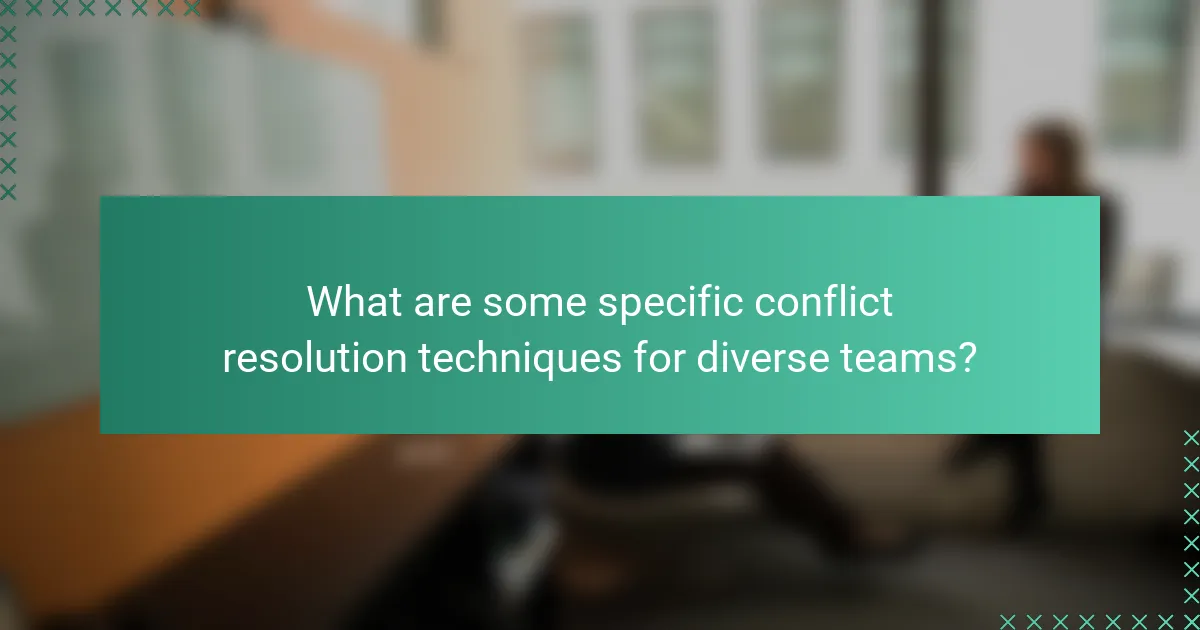
What are some specific conflict resolution techniques for diverse teams?
Active listening is a key conflict resolution technique for diverse teams. It involves fully concentrating on the speaker, understanding their message, and responding thoughtfully. This approach fosters mutual respect and understanding among team members. Another technique is mediation, where a neutral third party helps facilitate a discussion between conflicting parties. Mediation can clarify misunderstandings and promote collaborative solutions.
Collaborative problem-solving is also effective. This technique encourages team members to work together to identify common goals and develop solutions that satisfy everyone involved. Additionally, establishing ground rules for communication can prevent conflicts from escalating. Ground rules create a respectful environment for open dialogue.
Cultural competence training enhances awareness of diverse perspectives. This training equips team members with the skills to navigate differences effectively. Finally, using “I” statements can reduce defensiveness. This technique encourages individuals to express their feelings without blaming others, promoting a more constructive conversation.
What are the most effective conflict resolution techniques?
The most effective conflict resolution techniques include active listening, collaboration, and mediation. Active listening involves fully concentrating on the speaker, understanding their message, and responding thoughtfully. This technique fosters empathy and clarifies misunderstandings. Collaboration encourages all parties to work together to find a mutually beneficial solution. It promotes teamwork and strengthens relationships. Mediation involves a neutral third party facilitating the discussion between conflicting parties. This technique helps to ensure that everyone’s voice is heard and can lead to fair outcomes. These techniques have been proven effective in various settings, including workplaces and community organizations, as they promote open communication and understanding.
How can active listening improve conflict resolution outcomes?
Active listening can significantly improve conflict resolution outcomes by fostering understanding and empathy. It allows individuals to fully comprehend the perspectives of others involved in a conflict. This comprehension reduces misunderstandings and miscommunications. Research indicates that active listening can lead to a 70% increase in conflict resolution success rates. By validating emotions, active listening helps to de-escalate tensions. It encourages open dialogue, making parties feel heard and respected. Consequently, this creates a collaborative environment conducive to finding mutually acceptable solutions.
What role does mediation play in resolving team conflicts?
Mediation plays a crucial role in resolving team conflicts by facilitating communication between conflicting parties. It helps create a safe environment for open dialogue. Mediators guide discussions to ensure all voices are heard. This process encourages understanding and empathy among team members. Mediation can lead to collaborative problem-solving and mutually beneficial solutions. According to a study by the American Arbitration Association, mediation resolves approximately 85% of disputes. This demonstrates its effectiveness in conflict resolution. Mediation also helps maintain relationships by reducing hostility and fostering cooperation. Overall, mediation is an essential tool for managing and resolving team conflicts effectively.
How can teams evaluate their conflict resolution effectiveness?
Teams can evaluate their conflict resolution effectiveness by measuring outcomes and feedback. They should analyze the resolution process for clarity and communication. Surveys can gauge team members’ satisfaction with the resolution. Tracking recurring conflicts can indicate unresolved issues. Observing team dynamics post-resolution shows if relationships improved. Performance metrics can assess productivity changes after conflict resolution. Finally, documenting lessons learned helps refine future strategies. Research shows that effective evaluation leads to improved team collaboration and reduced conflict recurrence.
What metrics can be used to assess conflict resolution success?
Metrics to assess conflict resolution success include resolution rate, satisfaction surveys, and time to resolution. The resolution rate measures the percentage of conflicts resolved effectively. Satisfaction surveys gauge participant feelings about the resolution process. Time to resolution tracks how long it takes to resolve conflicts. These metrics provide tangible data on the effectiveness of conflict resolution strategies. Research indicates that organizations using these metrics see improved team dynamics and productivity.
How can feedback loops enhance conflict resolution practices?
Feedback loops enhance conflict resolution practices by facilitating continuous communication and improvement. They allow team members to share their perspectives and feelings openly. This process helps identify underlying issues that may not be immediately apparent. Regular feedback encourages accountability among team members. It fosters a culture of trust and collaboration. Research shows that teams with effective feedback mechanisms resolve conflicts more efficiently. A study by Stone and Heen (2014) indicates that constructive feedback can reduce misunderstandings and promote clarity. By integrating feedback loops, teams can create a more harmonious work environment.
What best practices can teams adopt for ongoing conflict resolution?
Teams can adopt several best practices for ongoing conflict resolution. First, establishing clear communication channels is essential. Open dialogue encourages team members to express concerns without fear. Regular check-ins can help identify potential conflicts early. Active listening is another critical practice. It ensures that all perspectives are heard and valued.
Implementing conflict resolution training can equip team members with necessary skills. This training can include techniques like negotiation and mediation. Encouraging collaboration fosters a team-oriented environment. When team members work together, they can find mutually beneficial solutions.
Setting clear expectations and roles minimizes misunderstandings. Clarity helps prevent conflicts from arising in the first place. Finally, seeking external mediation can be beneficial for persistent issues. Neutral third parties can provide unbiased perspectives and solutions. These practices collectively enhance a team’s ability to manage conflicts effectively.
How can teams create a culture of open communication?
Teams can create a culture of open communication by establishing clear communication channels. This includes regular team meetings and feedback sessions. Encouraging team members to share their thoughts openly is crucial. Active listening should be practiced by all members. Providing training on effective communication techniques enhances skills. Utilizing collaborative tools can facilitate ongoing dialogue. Establishing trust within the team fosters a safe environment for sharing. Research shows that teams with open communication are 25% more productive (Harvard Business Review, 2017).
What strategies can be employed to prevent conflicts from escalating?
Effective strategies to prevent conflicts from escalating include active listening, open communication, and establishing clear guidelines. Active listening allows team members to feel heard and understood, reducing tension. Open communication fosters transparency, enabling individuals to express concerns before they escalate. Establishing clear guidelines sets expectations for behavior and conflict resolution processes. Regular check-ins can also help identify issues early. Training in conflict resolution equips team members with the skills to address disputes constructively. By implementing these strategies, teams can create a collaborative environment that minimizes conflict escalation.
Conflict Resolution Strategies for Diverse Teams encompass methods such as open communication, active listening, and collaborative problem-solving to address misunderstandings and enhance team dynamics. The article explores the significance of conflict resolution in fostering collaboration among team members with varied perspectives and cultural backgrounds, highlighting common conflict types and their impact on team performance. It outlines key principles and techniques for effective resolution, including the role of empathy, mediation, and training programs, while also providing best practices for organizations to create a resolution-friendly environment. Additionally, the article emphasizes the importance of evaluating conflict resolution effectiveness through metrics and feedback loops to ensure continuous improvement in team collaboration.
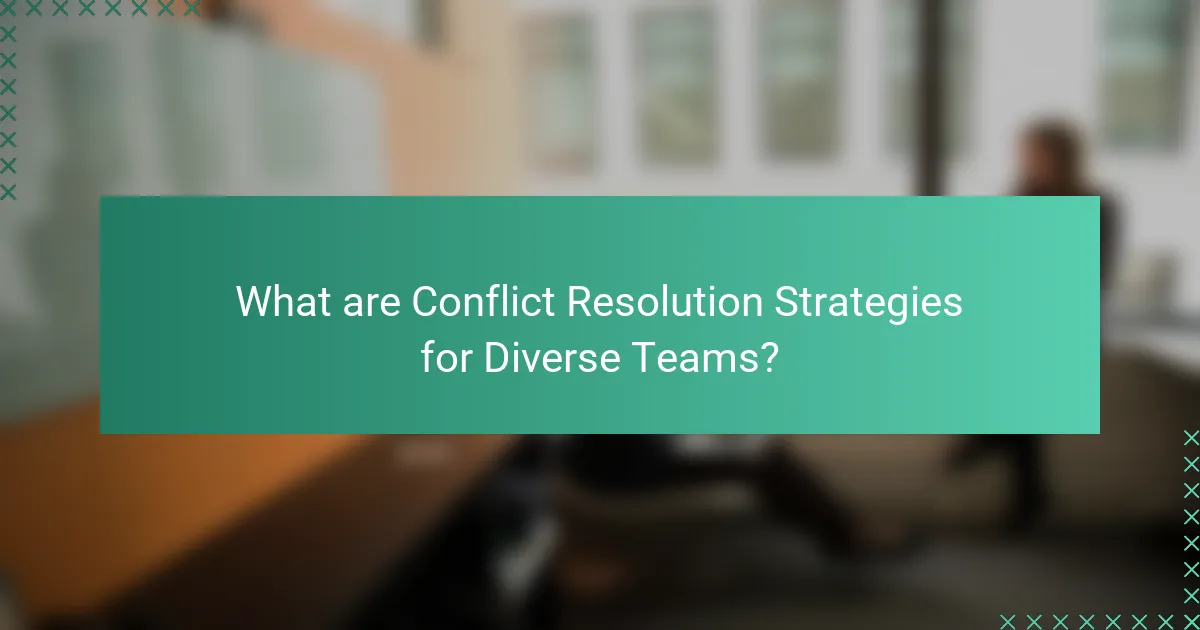
What are Conflict Resolution Strategies for Diverse Teams?
Conflict resolution strategies for diverse teams include open communication, active listening, and collaborative problem-solving. Open communication fosters an environment where team members can express their views. This approach helps to clarify misunderstandings and reduces tension. Active listening ensures that all voices are heard, validating each member’s perspective. Collaborative problem-solving encourages team members to work together to find solutions that accommodate diverse viewpoints.
Additionally, establishing ground rules for discussions can create a respectful atmosphere. Providing cultural competence training enhances understanding of different backgrounds. Mediation by a neutral third party can also facilitate resolution in more complex conflicts. These strategies are effective because they promote inclusivity and respect, leading to better team dynamics and productivity.
Why is conflict resolution important in diverse teams?
Conflict resolution is important in diverse teams because it fosters collaboration and understanding among team members. Diverse teams often bring different perspectives and cultural backgrounds. These differences can lead to misunderstandings and conflicts. Effective conflict resolution helps to address these issues constructively. It promotes open communication and encourages respect for differing viewpoints. Research shows that teams with effective conflict resolution strategies are more innovative and productive. According to a study published in the Journal of Organizational Behavior, teams that engage in constructive conflict resolution experience higher levels of collaboration and satisfaction. Thus, conflict resolution is essential for maximizing the strengths of diverse teams.
What types of conflicts commonly arise in diverse teams?
Common conflicts in diverse teams include communication issues, cultural misunderstandings, and differing work styles. Communication issues arise from language barriers or varying communication preferences. Cultural misunderstandings can lead to misinterpretation of behaviors or values. Differing work styles may create friction between team members who prioritize tasks differently. Research indicates that these conflicts can hinder team performance and collaboration. A study by Jehn (1995) highlights that task-related conflicts are common in diverse groups, impacting overall effectiveness.
How does diversity impact conflict dynamics?
Diversity impacts conflict dynamics by introducing varying perspectives and communication styles. This variation can lead to misunderstandings and misinterpretations. For instance, cultural differences may cause individuals to interpret conflict cues differently. A study by Jehn and Mannix (2001) found that diverse teams experience both task-related conflicts and relationship conflicts. Task-related conflicts can enhance problem-solving by bringing in multiple viewpoints. However, relationship conflicts can escalate tensions if not managed properly. Effective conflict resolution strategies must consider these diverse perspectives to foster collaboration. Understanding diversity’s role in conflict can improve team dynamics and outcomes.
What are the key principles of effective conflict resolution?
The key principles of effective conflict resolution include open communication, active listening, and collaboration. Open communication ensures all parties express their views clearly. This transparency builds trust and understanding among team members. Active listening involves paying attention to others’ perspectives without interruption. It fosters empathy and helps identify underlying issues. Collaboration encourages finding mutually beneficial solutions. This principle promotes teamwork and collective problem-solving. Additionally, maintaining respect throughout the process is crucial. Respectful interactions reduce defensiveness and facilitate constructive dialogue. Lastly, focusing on interests rather than positions leads to more effective outcomes. This approach allows for creative solutions that satisfy everyone’s needs.
How do communication styles affect conflict resolution?
Communication styles significantly influence conflict resolution. Different styles can either facilitate or hinder the resolution process. For instance, assertive communication encourages open dialogue and clarity. This approach helps parties express their needs without aggression. Conversely, passive communication may lead to misunderstandings. Individuals using this style often avoid confrontation, which can prolong conflicts.
Research indicates that collaborative communication leads to better outcomes in conflict situations. A study by Thomas-Kilmann identifies five conflict-handling modes, emphasizing the importance of adapting communication styles to the context. Effective communication fosters empathy and understanding, essential for resolving conflicts. Therefore, recognizing and adapting to various communication styles is crucial for successful conflict resolution in diverse teams.
What role does empathy play in resolving conflicts?
Empathy plays a crucial role in resolving conflicts by fostering understanding between opposing parties. It allows individuals to recognize and appreciate each other’s feelings and perspectives. This understanding can reduce hostility and promote cooperation. Empathy encourages open communication, which is essential for conflict resolution. According to a study published in the Journal of Conflict Resolution, empathetic approaches lead to more successful negotiation outcomes. By acknowledging emotions, parties can find common ground more effectively. This process can transform adversarial interactions into collaborative problem-solving. Thus, empathy is a key component in facilitating resolution in diverse teams.
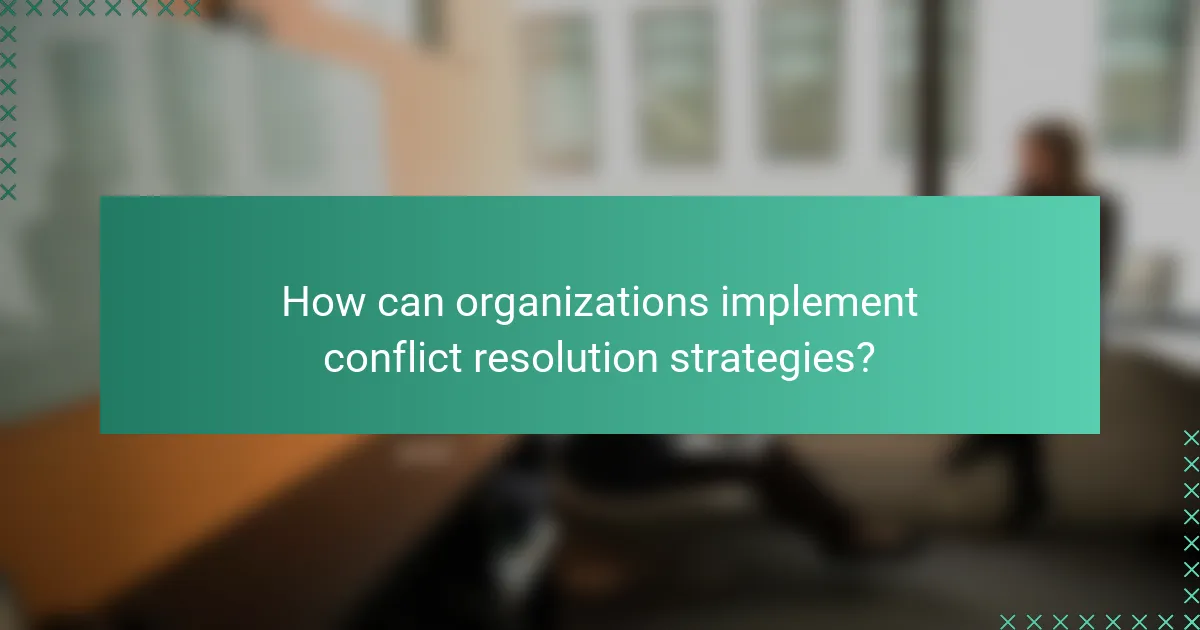
How can organizations implement conflict resolution strategies?
Organizations can implement conflict resolution strategies by establishing clear communication channels. Effective communication allows team members to express their concerns openly. Training staff in conflict resolution techniques is also essential. This training equips employees with the skills to manage disputes constructively.
Additionally, organizations should encourage a collaborative environment. A culture of teamwork fosters understanding and reduces tensions. Implementing mediation processes can help resolve conflicts before they escalate. Mediation provides a neutral space for parties to discuss their issues.
Regularly reviewing conflict resolution policies is crucial. This ensures that strategies remain relevant and effective. Research shows that organizations with structured conflict resolution processes experience less employee turnover. This indicates that effective strategies contribute to a positive workplace culture.
What steps should organizations take to foster a resolution-friendly environment?
Organizations should implement clear communication policies to foster a resolution-friendly environment. Open channels for dialogue encourage team members to express concerns. Regular training in conflict resolution skills promotes understanding and empathy. Establishing a safe space for discussions helps reduce fear of repercussions. Encouraging collaboration on problem-solving builds trust among team members. Leadership should model conflict resolution behaviors to set a positive example. Providing resources, such as mediation services, can facilitate effective resolutions. Finally, regularly assessing the workplace culture ensures ongoing improvement in conflict management practices.
How can training programs enhance conflict resolution skills?
Training programs can enhance conflict resolution skills by providing structured learning experiences. These programs teach participants effective communication techniques. They also offer strategies for identifying underlying issues in conflicts. Role-playing scenarios allow individuals to practice responses in a safe environment. Feedback from trainers helps refine conflict resolution approaches. Research indicates that trained individuals are more likely to resolve disputes amicably. According to a study by Jehn and Mannix (2001), teams with conflict resolution training experience improved collaboration and reduced misunderstandings. Overall, training equips individuals with the tools needed to navigate conflicts successfully.
What policies support effective conflict resolution in diverse teams?
Policies that support effective conflict resolution in diverse teams include clear communication guidelines, diversity training, and conflict resolution frameworks. Clear communication guidelines help ensure that all team members express their thoughts and feelings openly. Diversity training fosters understanding and respect among team members from different backgrounds. Conflict resolution frameworks provide structured approaches for addressing disputes, ensuring fairness and consistency. Research indicates that teams with established conflict resolution policies experience reduced misunderstandings and increased collaboration. These policies create an environment where diverse perspectives are valued, leading to improved team dynamics and performance.
How can leaders facilitate conflict resolution in diverse teams?
Leaders can facilitate conflict resolution in diverse teams by promoting open communication. They should encourage team members to express their viewpoints. This helps in understanding different perspectives. Leaders can also establish ground rules for respectful dialogue. Setting a framework for discussions mitigates misunderstandings. Mediation by leaders can help guide conversations toward resolution. They can identify common goals to unify team members. Additionally, training in cultural competence can enhance empathy among team members. Research shows that effective communication reduces conflict and fosters collaboration.
What leadership styles are most effective in conflict resolution?
Transformational and collaborative leadership styles are most effective in conflict resolution. Transformational leaders inspire and motivate team members to work towards a common goal. They encourage open communication and foster a supportive environment. Collaborative leaders prioritize teamwork and seek input from all team members. This inclusivity helps to address conflicts constructively. Studies show that these styles lead to higher satisfaction and better outcomes in diverse teams. For instance, a study published in the Journal of Organizational Behavior highlights that transformational leadership enhances team cohesion and reduces conflict.
How can leaders model conflict resolution behaviors?
Leaders can model conflict resolution behaviors by demonstrating effective communication and active listening. They should approach conflicts with an open mind and encourage dialogue among team members. Leaders must remain calm and objective, setting a positive example for others. They can also facilitate discussions that focus on finding common ground. By acknowledging different perspectives, leaders validate team members’ feelings and promote understanding. Furthermore, they can teach problem-solving techniques that help resolve disputes constructively. Research shows that leaders who actively engage in conflict resolution foster a collaborative team environment, leading to improved morale and productivity.
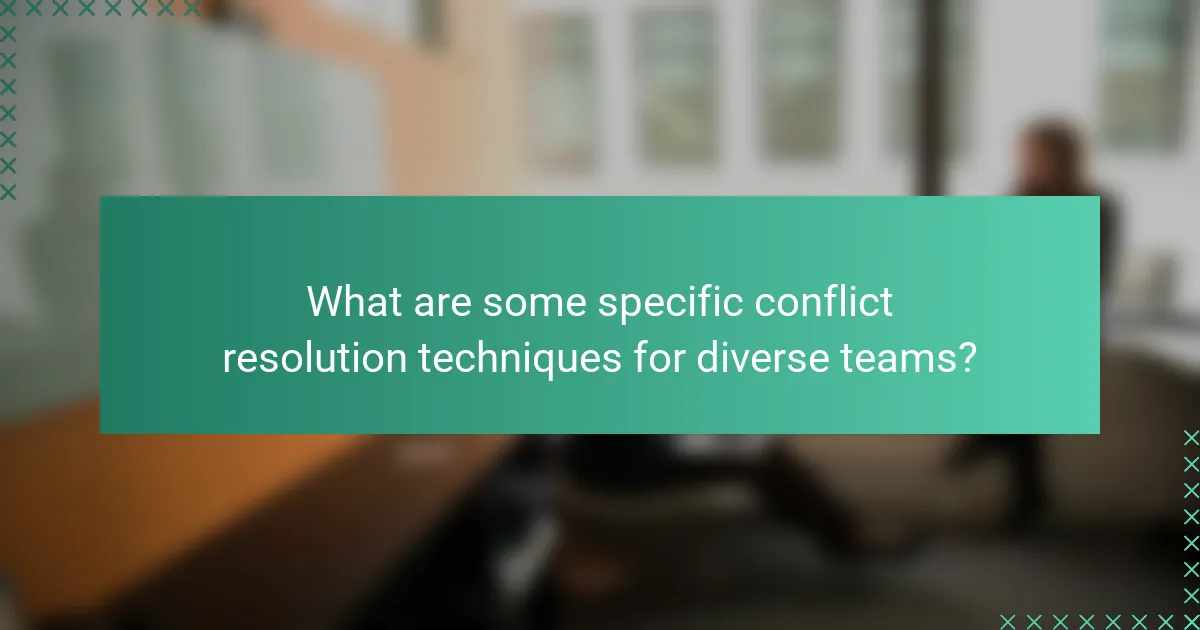
What are some specific conflict resolution techniques for diverse teams?
Active listening is a key conflict resolution technique for diverse teams. It involves fully concentrating on the speaker, understanding their message, and responding thoughtfully. This approach fosters mutual respect and understanding among team members. Another technique is mediation, where a neutral third party helps facilitate a discussion between conflicting parties. Mediation can clarify misunderstandings and promote collaborative solutions.
Collaborative problem-solving is also effective. This technique encourages team members to work together to identify common goals and develop solutions that satisfy everyone involved. Additionally, establishing ground rules for communication can prevent conflicts from escalating. Ground rules create a respectful environment for open dialogue.
Cultural competence training enhances awareness of diverse perspectives. This training equips team members with the skills to navigate differences effectively. Finally, using “I” statements can reduce defensiveness. This technique encourages individuals to express their feelings without blaming others, promoting a more constructive conversation.
What are the most effective conflict resolution techniques?
The most effective conflict resolution techniques include active listening, collaboration, and mediation. Active listening involves fully concentrating on the speaker, understanding their message, and responding thoughtfully. This technique fosters empathy and clarifies misunderstandings. Collaboration encourages all parties to work together to find a mutually beneficial solution. It promotes teamwork and strengthens relationships. Mediation involves a neutral third party facilitating the discussion between conflicting parties. This technique helps to ensure that everyone’s voice is heard and can lead to fair outcomes. These techniques have been proven effective in various settings, including workplaces and community organizations, as they promote open communication and understanding.
How can active listening improve conflict resolution outcomes?
Active listening can significantly improve conflict resolution outcomes by fostering understanding and empathy. It allows individuals to fully comprehend the perspectives of others involved in a conflict. This comprehension reduces misunderstandings and miscommunications. Research indicates that active listening can lead to a 70% increase in conflict resolution success rates. By validating emotions, active listening helps to de-escalate tensions. It encourages open dialogue, making parties feel heard and respected. Consequently, this creates a collaborative environment conducive to finding mutually acceptable solutions.
What role does mediation play in resolving team conflicts?
Mediation plays a crucial role in resolving team conflicts by facilitating communication between conflicting parties. It helps create a safe environment for open dialogue. Mediators guide discussions to ensure all voices are heard. This process encourages understanding and empathy among team members. Mediation can lead to collaborative problem-solving and mutually beneficial solutions. According to a study by the American Arbitration Association, mediation resolves approximately 85% of disputes. This demonstrates its effectiveness in conflict resolution. Mediation also helps maintain relationships by reducing hostility and fostering cooperation. Overall, mediation is an essential tool for managing and resolving team conflicts effectively.
How can teams evaluate their conflict resolution effectiveness?
Teams can evaluate their conflict resolution effectiveness by measuring outcomes and feedback. They should analyze the resolution process for clarity and communication. Surveys can gauge team members’ satisfaction with the resolution. Tracking recurring conflicts can indicate unresolved issues. Observing team dynamics post-resolution shows if relationships improved. Performance metrics can assess productivity changes after conflict resolution. Finally, documenting lessons learned helps refine future strategies. Research shows that effective evaluation leads to improved team collaboration and reduced conflict recurrence.
What metrics can be used to assess conflict resolution success?
Metrics to assess conflict resolution success include resolution rate, satisfaction surveys, and time to resolution. The resolution rate measures the percentage of conflicts resolved effectively. Satisfaction surveys gauge participant feelings about the resolution process. Time to resolution tracks how long it takes to resolve conflicts. These metrics provide tangible data on the effectiveness of conflict resolution strategies. Research indicates that organizations using these metrics see improved team dynamics and productivity.
How can feedback loops enhance conflict resolution practices?
Feedback loops enhance conflict resolution practices by facilitating continuous communication and improvement. They allow team members to share their perspectives and feelings openly. This process helps identify underlying issues that may not be immediately apparent. Regular feedback encourages accountability among team members. It fosters a culture of trust and collaboration. Research shows that teams with effective feedback mechanisms resolve conflicts more efficiently. A study by Stone and Heen (2014) indicates that constructive feedback can reduce misunderstandings and promote clarity. By integrating feedback loops, teams can create a more harmonious work environment.
What best practices can teams adopt for ongoing conflict resolution?
Teams can adopt several best practices for ongoing conflict resolution. First, establishing clear communication channels is essential. Open dialogue encourages team members to express concerns without fear. Regular check-ins can help identify potential conflicts early. Active listening is another critical practice. It ensures that all perspectives are heard and valued.
Implementing conflict resolution training can equip team members with necessary skills. This training can include techniques like negotiation and mediation. Encouraging collaboration fosters a team-oriented environment. When team members work together, they can find mutually beneficial solutions.
Setting clear expectations and roles minimizes misunderstandings. Clarity helps prevent conflicts from arising in the first place. Finally, seeking external mediation can be beneficial for persistent issues. Neutral third parties can provide unbiased perspectives and solutions. These practices collectively enhance a team’s ability to manage conflicts effectively.
How can teams create a culture of open communication?
Teams can create a culture of open communication by establishing clear communication channels. This includes regular team meetings and feedback sessions. Encouraging team members to share their thoughts openly is crucial. Active listening should be practiced by all members. Providing training on effective communication techniques enhances skills. Utilizing collaborative tools can facilitate ongoing dialogue. Establishing trust within the team fosters a safe environment for sharing. Research shows that teams with open communication are 25% more productive (Harvard Business Review, 2017).
What strategies can be employed to prevent conflicts from escalating?
Effective strategies to prevent conflicts from escalating include active listening, open communication, and establishing clear guidelines. Active listening allows team members to feel heard and understood, reducing tension. Open communication fosters transparency, enabling individuals to express concerns before they escalate. Establishing clear guidelines sets expectations for behavior and conflict resolution processes. Regular check-ins can also help identify issues early. Training in conflict resolution equips team members with the skills to address disputes constructively. By implementing these strategies, teams can create a collaborative environment that minimizes conflict escalation.
